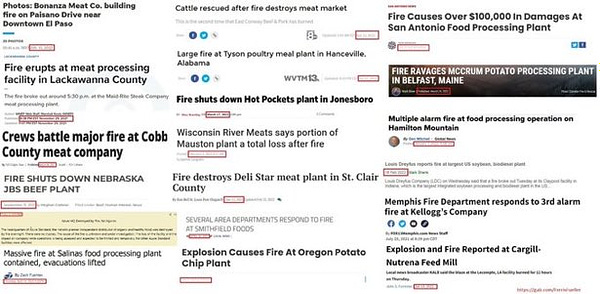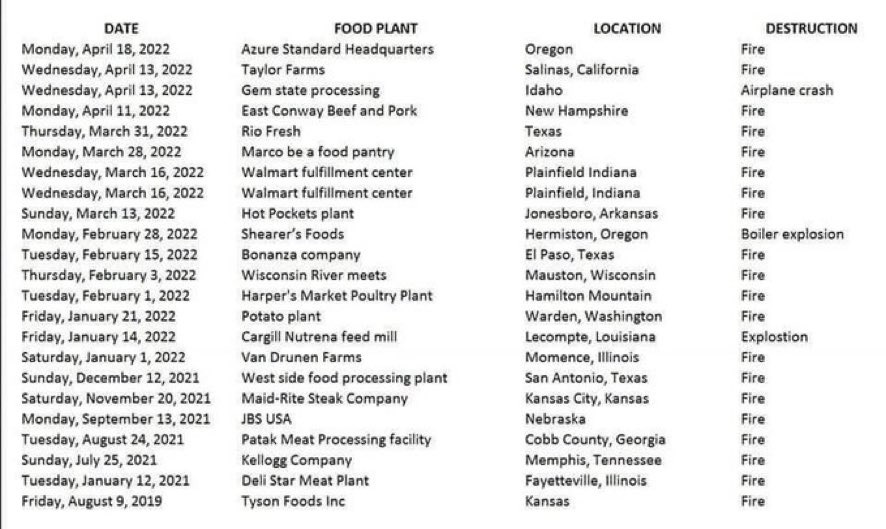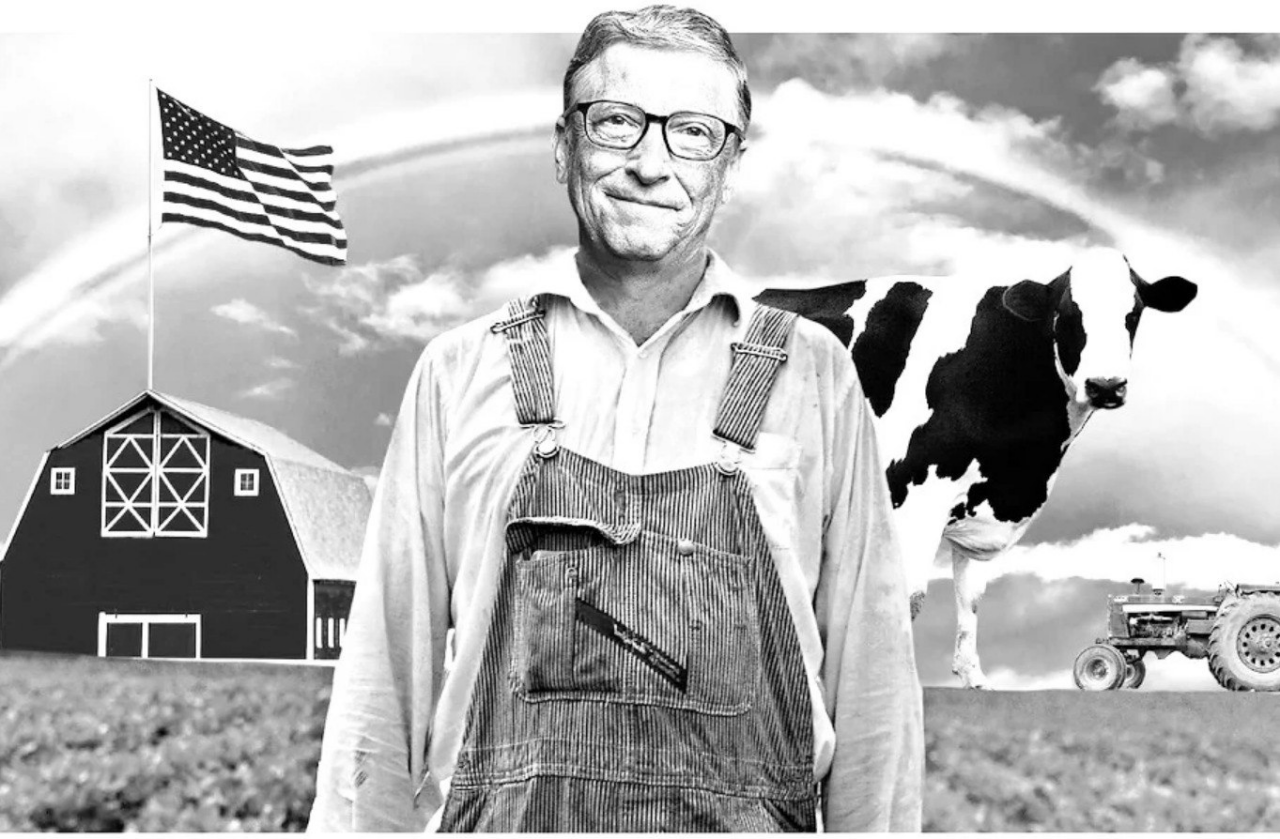people keep asking me about the purported rise in food processing plant fires and whether it constitutes some sort of concerted sabotage program, so i thought i’d take a quick spin through the data.
spoiler alert: i’ve seen no compelling evidence that this looks either terribly unusual or like an attack, concerted or otherwise.
the issue seems to arise because it is alleged that “lots of fires seem to be getting reported.”
many words in that phrase are important, especially “getting reported” because while this is suddenly all over the media, we have no idea if that is meaningful.
you can oftentimes get reporting bias where some issue not previously deemed newsworthy suddenly becomes faddish and every time a circuit breaker blows at some plant, the reporters rush to the scene and breathlessly catalogue an event that last year would have passed without comment.
this can lead to massively distorted senses of reality. long time gatopal™ coyote of the deeply wonderful coyoteblog did a fantastic job of demonstrating this back during “the summer of the shark.” (HERE)
this was an odd and enduring summer-long media phenomenon. sharks literally became the third biggest media story of the year measured by time dedicated to it on the top 3 broadcast networks.
every week was shark week.
this generated more than a little fear but it was merely sensationalist hallucination.
he lays the issue out succinctly here:
The media has two bad habits that make it virtually impossible for consumers of, say, television news to get a good understanding of trends
They highlight events in the tail ends of the normal distribution and authoritatively declare that these data points represent some sort of trend or shift in the mean
They mistake increases in their own coverage of certain phenomenon for an increase in the frequency of the phenomenon itself.
media breathlessly ascribed this to “global warming” and predicted new and dire times ahead where no beach was safe from merciless chondrichthyan incursion.
Except there was one problem -- there was no sharp increase in attacks. In the year 2001, five people died in 76 shark attacks. However, just a year earlier, 12 people had died in 85 attacks. The data showed that 2001 actually was a down year for shark attacks.
wah, waaaaah.
it literally turned out that it never happened. the year of the shark was a low year for shark attacks. amusingly, almost no one remembers it this way. most of the public still thinks the year of the shark was real.
and this is why you should NEVER trust this sort of clustering data without a base rate generated in some valid form.
24 food processing plants caught on fire!
sounds scary. but from that figure alone, you can tell nothing.


24 cars crash on the highway this week! that would be astoundingly low for a national future, but possibly quite worrying for a small local highway. is 24 food plant fires high? how can you tell?
first off, it helps to know how many there are. gatopal™ doomberg was kind enough to look that up for us. (animals are better at stats than humans. deal with it.)

so, a 1 in 1000 fire rate is far from crazy. one need not believe this to explain it:
the NFP states that the fire rate in an industrial building built in the last 30 years (though note we have no idea how old most plants are) is ~0.03% a year. so something on the order of 8-9 would be expected, though, of course, this is extremely rough as an amazon warehouse or a patio furniture distribution hub likely have FAR lower fire risk than someplace that might handle fertilizer, have large amounts of animal produced methane, or especially any sort of milling, etc.
note that since medieval times mills NEVER ran at night because the dust from turning grain to flour is one of the most explosively flammable things humans had created to date. like “boom! go pick up what’s left of your millstone in the next shire” kind of explosive. lots of finely powdered foodstuffs possess this property.
so we still don’t really have a strong idea of base rate, but it’s probably higher than average.
fortunately, i found this list which was interesting (albeit perhaps a bit over-inclusive, this being snopes and therefore tending to slant rather than play straight. but they did include a link to each story, so this is not invented and 20-22 look like comparable fires)
this certainly seems to make the list above look a bit less frightening.
24 vs 20-22 sure makes it look like we’re getting into the realm of “normal” and we still have no idea what the standard deviation is here. how variable is the series? is having twice the fires as last year a big outlier or does it happen all the time because the number bounces widely around a mean? it’s possible that any number between 10 and 40 is “normal” in any given year. going back to our “local highway” example, perhaps 3 cashed are normal, but every decade or so the weather is correct to turn one hill into black ice and then, large 20 car piles ups occur. it’s unusually, but also not odd. it’s just the shape of the distribution. this is not nearly as simple as it all looks and “base rate” even as an average or median means little without understanding typical deviation ranges and possible fat tail conditions.
is there some outcome slant ongoing?
are we seeing a clustering of deferred maintenance, unusually unskilled workers, or spare parts unavailability? are plants running unusual hours? there are just so many variables here.
also worth considering: what’s the likelihood that 24 arsons in a row got away with it despite this elevated level of scrutiny?
because that would seem to be quite a conspiracy as well…
the tinfoil is fun and some of the memes are classics, but as much as i love ascribing ill intent and outcomes to cardigan-clad james bond villains, i’m just not seeing it here and i think everyone expressing concern should pause and take a breath.
it sure looks to me like you’re getting sharked into the summer of the food fire.












Yes, not statistically significant on it's own. It becomes something larger when you zoom out and see "bird flu" culling by the tens of millions on multiple continents simultaneously. The intentional economic destruction via supply chain disruptions, engineered war in the bread basket of the world, fertilizer shortages, energy inflation that makes food production cost prohibitive, and recognize we're coming off two years of a bioweapon depopulation agenda and it all becomes something else entirely. Throw in floods in Iowa (geoengineering "seeding" clouds?) to prevent crop planting there, drought in the southwest to hinder crop mgmt there (why not seed clouds in the drought lands?), and Bill Gates who wants to bring the population down a few billion owning the most farm land and shit really starts to smell horrid.
"There has been a significant increase in the number of 'named storms' over the past fifty years." said the climate alarmist, breathlessly.
"Who named the storms?" asked the Mayor of Simpleton.
"Errrr..." replied the climate alarmist.